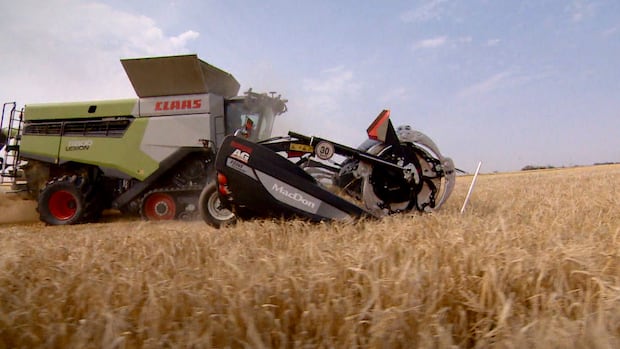
Ken Sarauer is driving his combine through a field of barley on his Saskatchewan farm. His hands are largely off the steering wheel.
The machine can harvest a row autonomously, allowing him to focus on several screens showing real-time data on his crops.
“I see it as lane assist in your car,” he said. “Everybody worries about automation taking jobs. But it allows you to do your job better.”
Sarauer’s family farm in Annaheim, Sask., about 125 kilometres east of Saskatoon, is one of a growing number turning to automation in face of a persistent labour shortage.
One-third of jobs in Canadian agriculture — about 100,000 — are expected to be automated in the next decade, according to new research from The Conference Board of Canada. Technology is now being used for everything from killing weeds and tracking crop health to self-driving grain carts and tillage equipment.
Darrell Petras, CEO of the Canadian Agri-Food Automation and Intelligence Network, said the industry is seeing robotics benefit farms of all scales, especially those in need of labour. His government-funded organization provides grants for early-stage projects.
“Maybe the temporary foreign worker component is a factor, but I also think it’s motivation at the farm level to drive a few things: productivity, profitability and sustainability,” said Petras, who is a former beef, dairy and grain farmer.
That drive toward automation comes as many manual farm tasks continue to be difficult to find labour for. More than 100,000 jobs are projected to be vacant by 2030, the Canadian Agricultural Human Resource Council predicts in its recent labour market report.
More Canadian farmers are getting a helping hand from automation such as driverless tractors and robot crop inspectors, a shift that’s been crucial in battling a chronic labour shortage.
‘It’s really not replacing jobs’
Farmers and agricultural tech companies say advances in automation are not putting people out of farm work. Instead, the new tools are freeing up existing workers tied up with often-monotonous tasks and allowing them to spend their time elsewhere.
On Sarauer’s farm, an automated camera device called SWAT CAM is attached to his sprayer. It replaces many of the manual tasks once done by an agronomist, including counting plant stems and weeds in the fields, by taking photos and using machine learning to process them.
Derek Rude is vice-president of research and development with Croptimistic, the Saskatchewan-based company behind the product. He says there’s a lot of interest from farmers in getting more reliable data on their crops, without having to spend extensive time scouting their fields.
“We’re not totally getting rid of the agronomists. We’re wanting them to do the higher skill analysis work,” he said. “These automation tools are just complementing what they’re already doing.”
PTx Trimble, a precision agriculture company in Winnipeg, is also trying to help farmers do more with their existing labour.
A team of engineers and software developers are fine-tuning self-driving grain carts and tillage equipment.
Darcy Cook, head of autonomous solutions, said when he demonstrates the self-driving tech at trade shows, many people tell him they see it as a solution to continue multi-generation family farms.
“The challenge is that farmers don’t have people when they need them at any given time. So it’s really not replacing jobs, it’s just allowing farmers, if they do have help, to deploy those to more valued operations,” he said.
Cook said efficiency and profitability are also part of the appeal, as the self-driving equipment can speed up operations.
“The sooner you can get that harvest done, the more value you can get from your crops and that’s the major payback,” he said.
‘I don’t need to be in the tractor’
Sarauer’s 1,450 hectare farm in Saskatchewan is normally a two-person operation: him and his dad. But the harvest season requires extra help from his uncles.
Sarauer is getting a new tractor that is supposed to be autonomous ready and hopes to be able to use it within the next five years. The more high-tech the farm gets, the easier it’ll be to run it himself.
There are some drawbacks to automation for family farms.
The technology can come with steep costs: up to $100,000 for self-driving equipment after subscription costs for software. Unlike large farms, which could test out one autonomous tractor in a fleet, small operations are forced to go all in.
Some types of autonomous tech, like the SWAT CAM, are more reasonable in price. It costs $3,500 for the device and then $0.50 per acre (0.4 hectares), with farmers agreeing to a long-term contract for the software.
Still, Sarauer said he’s a “big fan” of automation and willing to adapt where it makes his job easier.
“The problem is 90 per cent of the time, I don’t need to be in the tractor. I could be out doing something else,” he said. “My time is better spent marketing and doing the books.”
